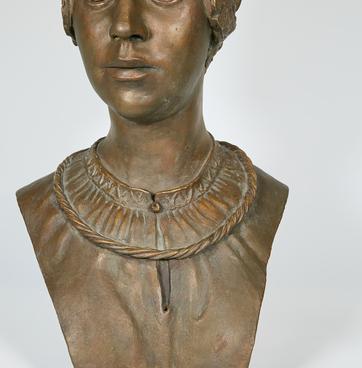In Russia, a travel set of shaving tools and other personal hygiene products was called a “necessaire” (from French nécessaire — “necessary”). Dressing cases appeared in France in the late 17th century and became popular in aristocratic circles of Europe and Russia. As a rule, such cases containing a set of various tools were rectangular or cylindrical in shape and came in different materials: wood, leather, precious metals, porcelain and crystal.
The dressing case presented in the Museum of Moscow is made of wood with an inlaid brass plate in the center of the hinged depicting the shield from the English coat of arms. There are two inserts in the case. Two folding straight razors, nail scissors, tweezers with an ear pick and a round stick with a screw thread at the end and a bone gimlet are securely fixed in special slots in the removable insert. The other insert at the bottom of the case houses a toothbrush, a brush for whipping and applying soap foam, a silver round soap container, a folding boot hook and an S-shaped hook used for hanging a belt when sharpening a razor. In the lid of the case, behind a plate with a built-in mirror, there is a sharpening blade for the razor in a flat case.
The presence of authentic stamps on the silver soap box allowed researchers to date the dressing case to 1809–1819. The master who made the soap box was Pierre-Noel Blaquier, who worked in Paris until the 1820s. The jeweler specialized in sets for dressing cases, cutlery, writing utensils and other items. Steel razor blades feature the marking MAIRE, the emblem of the Parisian manufacturer of steel items and jewelry Maison Maire, who was known for shaving kits and other types of dressing cases. Such a collaboration of craftsmen and a highly skilled execution of the box allowed experts to put forward the idea that the dressing case was made in the workshop of Martin-Guillaume Biennais, the court jeweler of Napoleon Bonaparte. This can be confirmed by comparing the exhibit with dressing cases that are attributed to the master, which are kept in various museum collections in France, Spain, Germany, and Russia.
The early 19th century was the era of the Napoleonic conquests. The French army was engaged in long campaigns, so soldiers and officers needed travel dressing cases. Parisian jewelers made large quantities of travel kits with folding cutlery and travel bags with personal hygiene products. Many were made in the same style, which indicates a certain unification. The presented dressing case came to Russia as a trophy. Most likely, it was seized from a defeated Frenchman and kept in a private collection for a long time.





